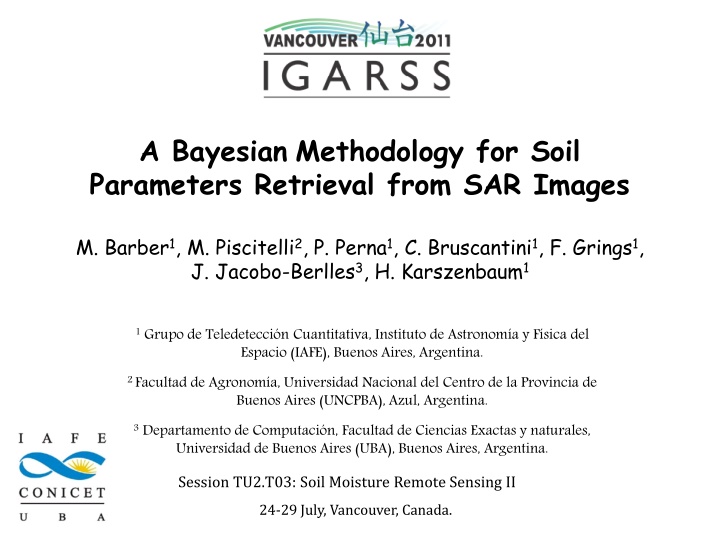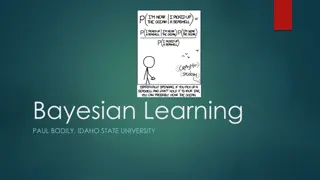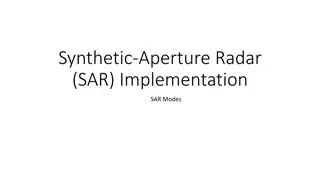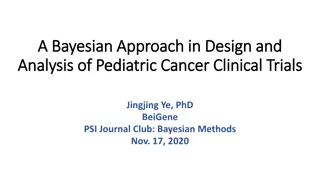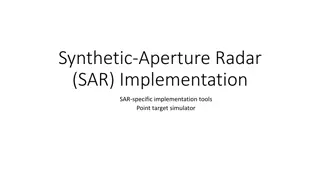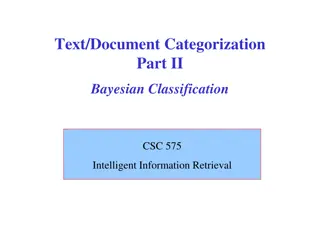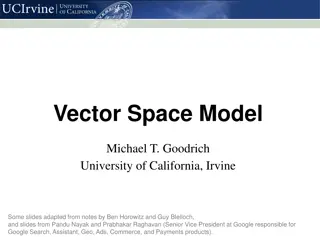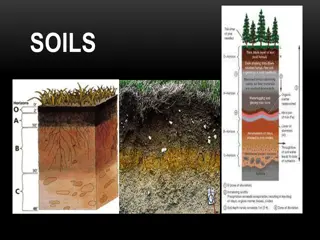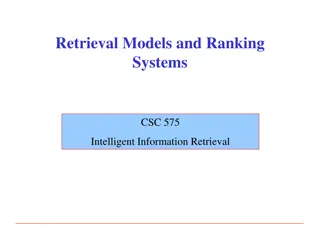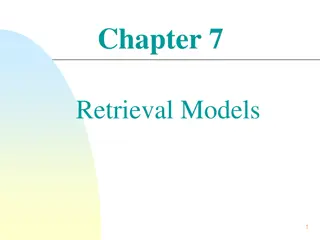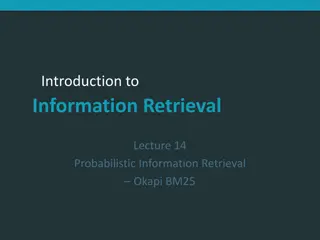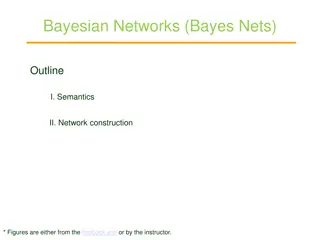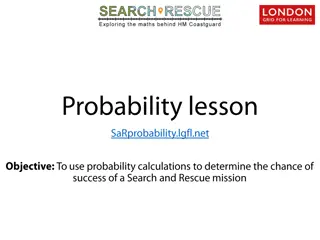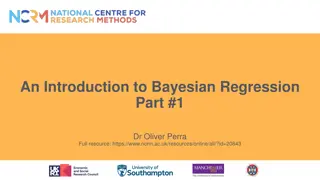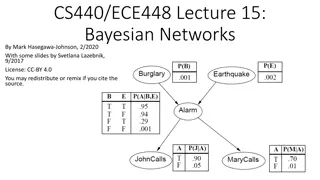Bayesian Methodology for Soil Parameters Retrieval from SAR Images
Surface soil moisture retrieval is crucial for various applications such as climatic modeling, hydrological studies, and agronomy. This work focuses on developing a soil moisture retrieval algorithm using the SAOCOM L-Band polarimetric SAR system in Argentina. Limiting factors include spatial variability, model parameter mismatches, and speckle noise. The Oh Model is discussed as an available retrieval model for bare soils, presenting constraints and inversion techniques.
Download Presentation

Please find below an Image/Link to download the presentation.
The content on the website is provided AS IS for your information and personal use only. It may not be sold, licensed, or shared on other websites without obtaining consent from the author.If you encounter any issues during the download, it is possible that the publisher has removed the file from their server.
You are allowed to download the files provided on this website for personal or commercial use, subject to the condition that they are used lawfully. All files are the property of their respective owners.
The content on the website is provided AS IS for your information and personal use only. It may not be sold, licensed, or shared on other websites without obtaining consent from the author.
E N D
Presentation Transcript
A Bayesian Methodology for Soil Parameters Retrieval from SAR Images M. Barber1, M. Piscitelli2, P. Perna1, C. Bruscantini1, F. Grings1, J. Jacobo-Berlles3, H. Karszenbaum1 1 Grupo de Teledetecci n Cuantitativa, Instituto de Astronom a y F sica del Espacio (IAFE), Buenos Aires, Argentina. 2 Facultad de Agronom a, Universidad Nacional del Centro de la Provincia de Buenos Aires (UNCPBA), Azul, Argentina. 3 Departamento de Computaci n, Facultad de Ciencias Exactas y naturales, Universidad de Buenos Aires (UBA), Buenos Aires, Argentina. Session TU2.T03: Soil Moisture Remote Sensing II 24-29 July, Vancouver, Canada.
Introduction and Motivation Surface soil moisture is a key variable related to: Climatic modeling (heat and mass transfer between Earth and atmosphere). Hydrological applications (water dynamics and runoff, both closely related with water erosion, risk of floods). Agronomical applications (vegetation and crops development). Argentina is building an L-Band full polarimetric SAR system named SAOCOM: Offering the opportunity of monitoring surface soil moisture content. In this context the goal of this work is to develop a soil moisture retrieval algorithm. As previous work a 3D laser profiler was developed and tested as part of the thesis done to complete my degree in Physics (Licenciatura en F sica). SAOCOM SAC-D To be Launched in 2011 Launched in 2015
Limiting factors for retrieval of soil moisture from SAR backscattering coefficients Concerning the surface soil moisture: It is a very heterogeneous variable across scales (high spatial and temporal variability) Concerning the forward models: Non-negligible mismatches between model parameters and measured data (statistical fluctuations, difficulty on parameterization of model variables, target s heterogeneity) Concerning the speckle noise: Arises due to the coherence nature of the imaging SAR system. Leads to a grain-like appearance of SAR images. Decreases the contrast and radiometric quality of SAR images. It is usually reduced by spatial averaging at the expense of spatial resolution. SAOCOM SAC-D To be Launched in 2011 Launched in 2015
Available retrieval models: Oh Model Main features regarding Oh Model [Oh 2004]: Applies only over bare soils. Relates soil parameters volumetric soil moisture m (cm3/cm3), normalized roughness rms height ks and correlation length kl (k=2 / ) to polarimetric backscattering coefficients hh, vv, vh. Semi-empirical. Presented in an algebraic, explicit way. Constrained to the range 0.04<m<0.291 cm3/cm3and 0.13<ks<6.98 (better agreement with ks<3.5). Straightforward inversion technique. Due to the insensitivity of the copolarized coefficients hh and vv to the correlation length kl and the problem of measuring it in the field, a rather desirable further formulation is made ignoring the correlation length so that: hh=f1(m,ks) vv=f2(m,ks) vh=f3(m,ks) This simplified formulation of Oh Model will be used throughout this work. SAOCOM SAC-D To be Launched in 2011 Launched in 2015
Concerning Oh Model, we should be aware of: It assumes a certain, unique m and ks value within a resolution cell (homogeneuos surface s target within a resolution cell) It takes into account no speckle effects at all (i.e. achieved by averaging) These facts will implicitly be in any retrieval scheme that uses Oh model as the forward model. Through a minimization procedure, Oh [Oh 2004] establishes an algorithm for retrieving soil moisture and roughness from a set of measured backscattering coefficients hh, vv and vh. Shaded area encloses the Oh Model validity region SAOCOM SAC-D To be Launched in 2011 Launched in 2015
Some questions arise: At certain vh values, is it possible that a measured (hh,vv) pair would lie outside the validity region? Yes, it certainly is (speckle noise and system uncertainities). Which soil moisture estimate should be chosen in case of a measured (hh,vv) pair laying outside the validity region? A minimum-distance criterion could be an option but would yield to strongly noisy estimations. In this sense a retrieval scheme based only in Oh Model is not suitable for real applications (i.e. those involving coherent imaging as from SAR systems). Then, we should deal with the speckle noise affecting SAR images. SAOCOM SAC-D To be Launched in 2011 Launched in 2015
Multiplicative Model for speckle The Multiplicative Model includes terrain backscatter and speckle noise Z=X.Y X and Y are assumed to be independent returnbackscatterspeckle If target is modeled without considering speckle, then Z=X.1 How can we develop a model that includes terrain features as well as speckle noise in order to achieve a suitable retrieval for soil parameters, mainly for soil moisture? SAOCOM SAC-D To be Launched in 2011 Launched in 2015
Bayes theorem Likelihood Prior Posterior Evidence The Posterior is conditional probability of measuring m and ks given measured SAR backscattering coefficients hh, vv, vh. The Likelihood involves forward model as well as speckle model. In the Prior is included all a priori information about m and ks. The Evidence is an overall normalization factor. Providing the conditional density function the optimal unbiased estimators are: D={0.04<m<0.297 cm3/cm3,0.13<ks<3.5). SAOCOM SAC-D To be Launched in 2011 Launched in 2015
In our case the Oh Model is rewritten in terms of the multiplicative model as hh =f1(m,ks) vv =f2(m,ks) vh=f3(m,ks) Z1=X1Y1 Z2=X2Y2 Z3=X3Y3 Model hypotheses 1) Xi=fi(M,KS) (i=1,2,3), so that firepresents the deterministic typical or average way in which the random variable Xidepends on the random variables M and KS (which represent target's m and ks). It is sound to state E[Xi]=fi(E[M],E[KS]), (i=1,2,3). Speckle adds only a multiplicative noise of mean value E[Yi]=1, (i=1,2,3). 2) 3) Under these hypotheses E[Zi]=E[Xi]E[Yi]=fi(E[M],E[KS]), (i=1,2,3) getting the proper average behavior for the returns in terms of the chosen forward model. SAOCOM SAC-D To be Launched in 2011 Launched in 2015
Model parameters In order to perform a numerical simulation, the following functions and model parameters are required: 1) 2) 3) Probability density function for M and KS. Prior. Number of looks n. For the purpose of the simulation, it will be assumed that: 1) 2) M and KS are normally distributed with m=0.005 and ks=0.01. the Prior is uniformly distributed: U[0.01-0.35] for m and U[0.1-4.0] for ks. n=3 and n=64 will be used for the number of looks. 3) SAOCOM SAC-D To be Launched in 2011 Launched in 2015
Results Case n=3 One-sigma standard deviation contour lines Estimated m Units of m in cm3/cm3 SAOCOM SAC-D To be Launched in 2011 Launched in 2015
Results Case n=64 One-sigma standard deviation contour lines Estimated m Units of m in cm3/cm3 SAOCOM SAC-D To be Launched in 2011 Launched in 2015
Results When using the Bayesian methodology, the retrieved soil moisture values cover the entire (hh,vv,vh)-space. When significant multi-looking is present the Bayesian retrieval looks more compact around the corresponding contour lines of Oh Model indicating a correct asymptotical behavior. In the same way, the one-sigma contour lines are also computed yielding an estimator for the retrieval errors. The relative improvement due to the increasing of the number of looks is displayed by the one-sigma contour lines (error decreases from 0.07 cm3/cm3to 0.03-0.04 cm3/cm3).
Concluding Remarks. Soil parameters retrieval from SAR data presents two main sources of uncertainty: terrain heterogeneity and speckle noise. These issues were included into a retrieval scheme by using a Bayesian methodology. Such a Bayesian methodology: Needs only a forward model (no retrieval model required) and a speckle model. Gives an estimator of soil parameters as well as their associated error. Can include prior information in order to improve the retrieval.
Work in progress. Height [cm] Length [cm] Width [cm] 3D laser profiler output from a real soil. Performance assessment of the Bayesian model using a non- uniform (informative) prior. Studying the sensitivity of the retrieval in terms of terrain heterogeneity parameters mand ks. Measuring in-situ roughness parameters over several soil tillages and soil types using the developed laser profiler (upper left figure) . This information will yield to a roughness map (upper right figure) which will link soil properties to probability distribution functions for s and will be further used as prior information.
